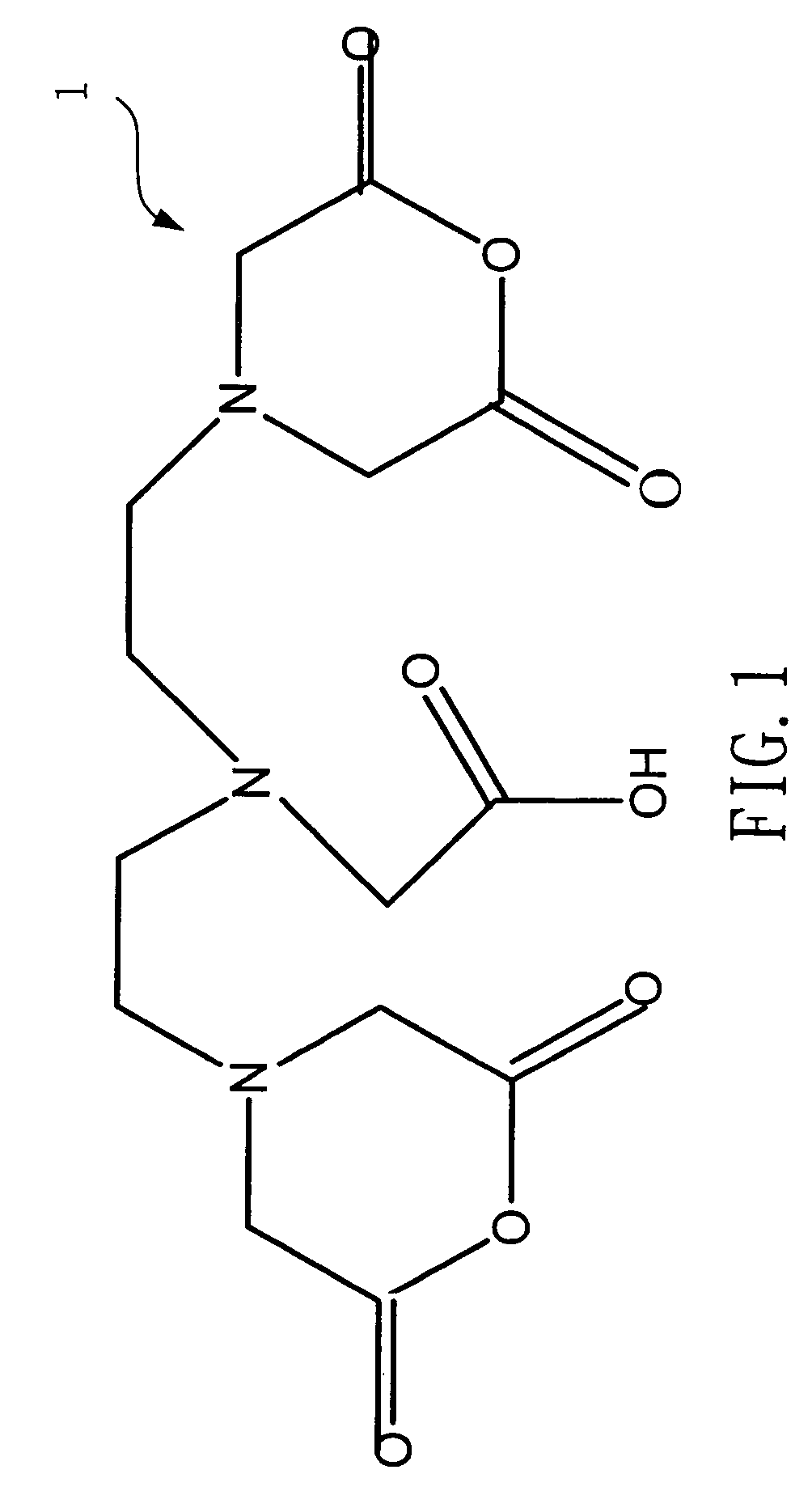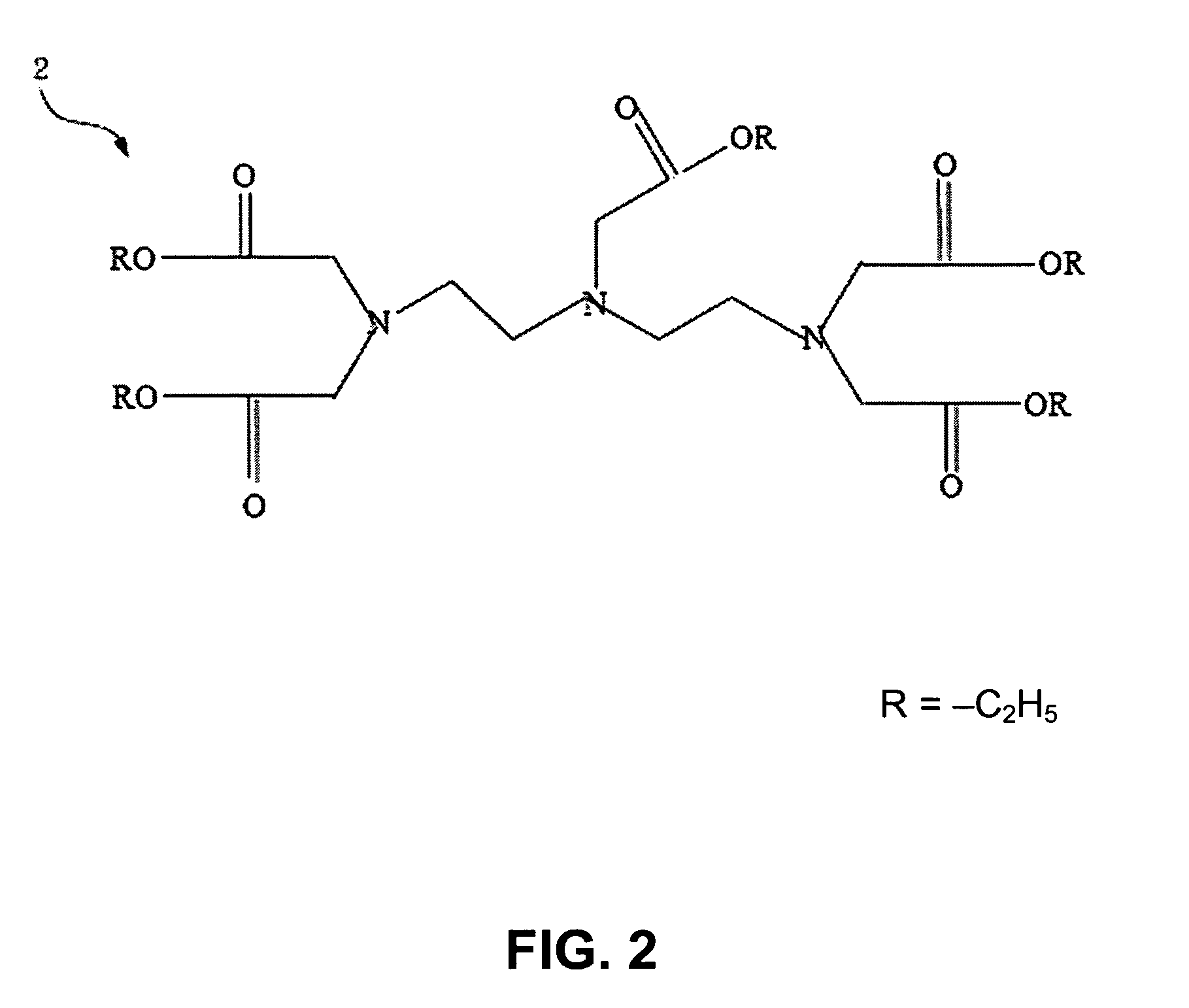Method for manufacturing diethylene triamine pentaacetic acid derivative
a technology of pentaacetic acid and diethylene triamine, which is applied in the preparation of amino-carboxyl compounds, chemistry apparatus and processes, organic chemistry, etc., can solve the problems of complex separation process in the above process, low yield rate, and prior art that does not fulfill users' requests for actual use, etc., to achieve simple production procedure and high yield rate
- Summary
- Abstract
- Description
- Claims
- Application Information
AI Technical Summary
Benefits of technology
Problems solved by technology
Method used
Image
Examples
example 1
A Synthesis of a penta-ethyl DTPA
[0023]Please refer to FIG. 1 and FIG. 2, which are views of the structures of a DTPA and a penta-ethyl DTPA according to the present invention. A 4g(gram) or 0.01 mole of a DTPA 1 is mixed with a 100 ml(milliliter) of ethanol to be catalyzed by dripping a 1.5 ml of sulfuric acid. Because an esterification is reversible reaction while water exists, the solvent is removed by a Dean-Stark apparatus after refluxing for 24 hours. Then, neutralization is processed with a saturate solution of a sodium bicarbonate to obtain a 4.86 g of a hazel viscous liquid of penta-ethyl DTPA 2, whose yield rate is 91%.
[0024]1H NMR (Nuclear Magnetic Resonance) (CDCl3 / δ ppm)[0025]δ 1.16˜1.23 (15H 5×—CH3)[0026]δ 2.78˜2.84 (8H 2×—N—CH2—CH2—N)[0027]δ 3.43˜3.53 (10H 5×—N—CH2—CO)[0028]δ 4.03˜4.33 (10H 5×—O—CH2)
[0029]13C NMR (CDCl3 / δ ppm)[0030]δ 41.07 δ 128.33[0031]δ 48.85 δ 128.56[0032]δ 50.66 δ 135.57[0033]δ 55.96 δ 169.61[0034]δ 57.08 δ 171.02[0035]δ 66.29
[0036]EIMS (electro-i...
example 2
A Synthesis of a tetra-ethyl DTPA
[0041]Please refer to FIG. 3, which is a view of the structure of a tetra-ethyl DTPA according to the present invention. The above-mentioned penta-ethyl DTPA 2 (1 g, 1.87 mole) and a CuCl2.2H2O (0.318 g, 1.87 millimole) are mixed in 34 ml of water as being stirred for 2 hours while being slowly added with 0.49 ml of sodium hydroxide (0.089 g, 2.244 millimole) solution to obtain a mixed liquid having Cu2S. The mixed liquid is bubbled with H2S and is filtrated with a filter paper to remove the Cu2S. In the end, through purification by a column, a 0.58 g of viscous tetra-ethyl DTPA 3 is obtained, whose yield rate is 61%. If the cupric chloride is substituted with NiCl2, the yield rate of the tetra-ethyl DTPA 3 can become 56%. If the sodium hydroxide is substituted with a potassium hydroxide, the yield rate of the tetra-ethyl DTPA 3 can become 58%.
[0042]1H NMR (CDCl3 / δ ppm)[0043]δ 1.10˜1.16 (m 12H 4×—CH3)[0044]δ 2.75˜2.82 (8H 2×—N—CH2—CH2—N)[0045]δ 3.37˜...
example 3
A Synthesis of a penta-tert-butyl DTPA
[0060]Please refer to FIG. 4, which is a view of the structure of a penta-tert-butyl DTPA according to the present invention. A diethylenetriamine (2 g, 9.69 millimole), a potassium carbonate (6.7 g) and a 70 ml of acetonitrile are placed in a flask as being stirred. And, a tert-butyl chloroacetate (8.32 ml, 58.16 millimole) dissolved in a 10 ml of acetonitrile is slowly added into the flask to process reactions for 24 hours. Then, the solvent of the solution is removed and the solution is filtrated. The ethyl ether and the hexane are mixed under a mixture rate of 1:10 in a chromatographic column to be separated and purified to obtain a 4.0 g of penta-tert-butyl DTPA 4, whose yield rate is 61%.
[0061]1H NMR (CDCl3 / δ ppm)[0062]δ 1.36 (45H 5×—O—C—(CH3)3)[0063]δ 2.71 (S 8H 2×—N—CH2—CH2—N)[0064]δ 3.27˜3.45 (10H 5×—N—CH2—CO)
[0065]13C NMR (CDCl3 / δ ppm)[0066]δ 28.06 δ 55.97 δ 80.72[0067]δ 52.09 δ 76.61 δ 70.55[0068]δ 52.68 δ 77.03[0069]δ 55.67 δ 77.46
[0...
PUM
| Property | Measurement | Unit |
|---|---|---|
| yield rate | aaaaa | aaaaa |
| yield rate | aaaaa | aaaaa |
| yield rate | aaaaa | aaaaa |
Abstract
Description
Claims
Application Information
 Login to View More
Login to View More - R&D
- Intellectual Property
- Life Sciences
- Materials
- Tech Scout
- Unparalleled Data Quality
- Higher Quality Content
- 60% Fewer Hallucinations
Browse by: Latest US Patents, China's latest patents, Technical Efficacy Thesaurus, Application Domain, Technology Topic, Popular Technical Reports.
© 2025 PatSnap. All rights reserved.Legal|Privacy policy|Modern Slavery Act Transparency Statement|Sitemap|About US| Contact US: help@patsnap.com



